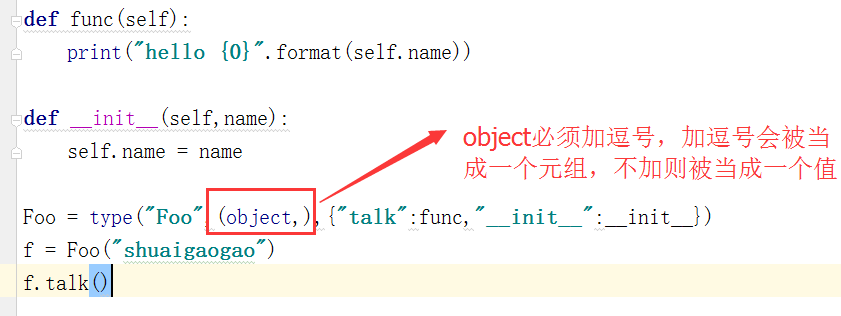反射
反射我们以后会经常用到,这个东西实现了动态的装配,通过字符串来反射类中的属性和方法
反射函数
1、hasarttr(obj,name_str)
作用:判断一个对象obj中是否有对应的name_str字符串的属性或者方法

class Dog(object): def __init__(self,name): self.name = name def eat(self,food): print("{0} is eating...{1}".format(self.name,food)) d = Dog("shabi") choice = input(">>>:").strip() print(hasattr(d,choice)) #obj中是否有对应的choice字符串的属性或者方法 #输出 >>>:name #输入对象存在属性 True >>>:eat #输入对象存在的方法 True
2、getattr(obj,name_str)
作用:根据字符串name_str获取obj对象中的对应方法的内存地址或者对应属性的值

class Dog(object): def __init__(self,name): self.name = name def eat(self,food): print("{0} is eating...{1}".format(self.name,food)) d = Dog("shabi") choice = input(">>>:").strip() print(getattr(d,choice)) #choice获取obj对象中的对应方法的内存地址或者对应属性的值 #输出 >>>:name #返回name属性的值 shabi >>>:eat <bound method Dog.eat of <__main__.Dog object at 0x00000157A129CF28>> #返回eat方法的内存地址
3、setattr(x,y,z)
作用:给obj对象添加一个新属性或者新方法,setattr(x, 'y', v) is equivalent to ``x.y = v''
①给对象新增一个新方法

def bulk(self): #先定义一个bulk函数 print("{0} is yelling...".format(self.name)) class Dog(object): def __init__(self,name): self.name = name def eat(self,food): print("{0} is eating...{1}".format(self.name,food)) d = Dog("shabi") choice = input(">>>:").strip() setattr(d,choice,bulk) #输入的是talk,所以又等同于d.talk = bulk #d.talk(d) 直接写死,用d.talk(d),一般不这么写 func = getattr(d,choice) #用getattr来获取 func(d) #输出 >>>:talk shabi is yelling...
②给对象新增一个属性

class Dog(object): def __init__(self,name): self.name = name def eat(self,food): print("{0} is eating...{1}".format(self.name,food)) d = Dog("shabi") choice = input(">>>:").strip() setattr(d,choice,22) #输入的是age,所以又等同于d.age = 22 # print(d.age) 这样就写死了,还是用下面一种 print(getattr(d,choice)) #输出 >>>:age 22
4、delattr(x,y)
作用:删除obj对象中的属性或者方法,delattr(x, 'y') is equivalent to ``del x.y''

class Dog(object): def __init__(self,name): self.name = name def eat(self,food): print("{0} is eating...{1}".format(self.name,food)) d = Dog("shabi") choice = input(">>>:").strip() delattr(d,choice) #根据字符串删除属性或者方法 print(d.name) print(d.eat) #输出 >>>:name #删除属性name Traceback (most recent call last): print(d.name) AttributeError: 'Dog' object has no attribute 'name' >>>:eat #删除方法eat Traceback (most recent call last): delattr(d,choice) AttributeError: eat
5、综合使用hasattr、getattr、setattr

class Dog(object): def __init__(self,name): self.name = name def eat(self,food): print("{0} is eating...{1}".format(self.name,food)) d = Dog("shabi") choice = input(">>>:").strip() if hasattr(d,choice): #判断d对象中存在属性和方法 name_value = getattr(d,choice) #获取属性值 print(name_value) setattr(d,choice,"hong") #修改属性值 print(getattr(d,choice)) #重新获取属性的值 else: setattr(d,choice,None) #设置不存在的属性值为None v = getattr(d,choice) print(v) #输出 >>>:name shabi hong >>>:abc None
创建
前面的随笔都是关于类的知识,通过类创建对象,那这个类到底是怎么产生的呢?
1、 传统创建类

class Foo(object): def __init__(self,name): self.name = name f = Foo("shuaigaogao")
f 是通过 Foo 类实例化的对象,其实,不仅 f 是一个对象,Foo类本身也是一个对象,因为在Python中一切事物都是对象,按照一切事物都是对象的理论:obj对象是通过执行Foo类的构造方法创建,那么Foo类对象应该也是通过执行某个类的构造方法创建。
print(type(f)) #输出:<class '__main__.Foo'> 表示:f 对象由Foo类创建 print(type(Foo)) #输出:<class 'type'> 表示:Foo类对象由 type 类创建
所以,f 对象是Foo类的一个实例,Foo类对象是 type 类的一个实例,即:Foo类对象 是通过type类的构造方法创建
2 、type创建类
说明: type创建类的格式,类名 = type('类名',(父类,),{'方法名':方法的内存地址})

def func(self): #创建方法 print("hello {0}".format(self.name)) def __init__(self,name): #创建构造方法 self.name = name #通过type创建类,如果是经典类的话则写成:Foo = type("Foo",(),{"talk":func,"__init__":__init__}) Foo = type("Foo",(object,),{"talk":func,"__init__":__init__}) f = Foo("shuaigaogao") #创建对象 f.talk() #输出 hello shuaigaogao
总结:类 是由 type 类 实例化产生的
值得注意的是,新式类的写法,在继承父类那边,你继承一个父类后面就要加一个逗号,加逗号,它就把它当做一个元组,不加逗号,就是一个值了

